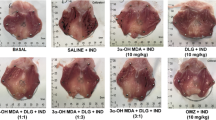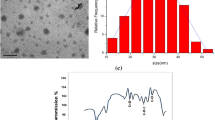Abstract
In the last several years, it has been proposed that neutrophil- and oxygen-dependent microvascular injuries may be important factors in the gastrointestinal toxicity of nonsteroidal antiinflammatory drugs (NSAIDs). In addition, after oral administration, reduced levels of gastric mucosal adenosine triphosphate in response to mitochondrial damage constitute the earliest event on topical mucosal erosions. In these experiments, we compared the implication of active oxygen, lipid peroxidation levels and neutrophil infiltration in gastric mucosal injury induced by the analgesic–antipyretic drugs, dipyrone (pyrazolone derivative) and acetaminophen (nonacidic drug), both with relatively weak antiinflammatory effects, with diclofenac (an acidic NSAID). After 6 hr of oral administration, dipyrone (120 and 500 mg/kg) did not provoke macroscopic lesions on rat gastric mucosa. Only the highest dose (1000 mg/kg) induced slight erosions similar to the same dose of acetaminophen without modifications in lipid peroxidation levels or myeloperoxidase activity. The area of mucosa with lesions, the increase in neutrophil infiltration, and concentration of TBA-reactive substances was significantly higher with diclofenac (50 mg/kg). By contrast, inhibition in superoxide dismutase activity was observed. In a dose-dependent manner, dipyrone and diclofenac decreased the levels of endogenous gluthatione, and the highest dose (1000 mg/kg) also inhibited glutathione peroxidase activity. None of treatments induced changes in xanthine oxidase activity, an index of ischemic condition. These findings confirm the favorable gastric tolerability of dipyrone, since only the highest dose produced weak mucosal lesions similar to that obtained with acetaminophen, and this effect only could be related to a diminished glutathione metabolism. In contrast, diclofenac induced significant erosions, and the data obtained indicate that the enhancement of oxidative stress plays an important role in the pathogenesis of damage.
Similar content being viewed by others
REFERENCES
Aly A: NSAID-induced ulcer and its complications. Nord Med 112:195–197, 1997
Singh G: Recent considerations in nonsteroidal antiinflammatory drug gastropathy. Am J Med 27:31S–38S, 1998
Fosslien E: Adverse efects of nonsteroidal anti inflammatory drugs on the gastrointestinal system. Ann Clin Lab Sci 28(2):67–81, 1998
Mahmud T, Rafi SS, Scott DL, Wrigglesworth JM, Bjarnason I: Nonsteroidal antiinflammatory drugs and uncoupling of mitochondrial oxidative phosphorylation. Arthritis Rheum 39(12):1998–2003, 1996
Somasundaram S, Rafi S, Hayllar J, Sigthorsson G, Jacob M, Price AB, Macpherson A, Mahmod T, Scott D, Wrigglesworth JM, Bjarnason I: Mitochondrial damage: A possible mechanism of topical phase of NSAID induced injury to the rat intestine. Gut 41:344–353, 1997
Wallace JL, Keenan CM, Granger DN: Gastric ulceration induced by nonsteroidal antiinflammatory drugs is a neutrophil-dependent process. Am J Physiol 259:G462–G467, 1990
Naito Y, Yoshikawa T, Kaneko T, Linuma S, Nishimura S, Takahashi S, Kondo M: Role of oxygen radicals in indomethacin-induced gastric mucosal microvascular injury in rats. J Clin Gastroenterol 17:S99–S103, 1993
Yoshikawa T, Naito Y, Kishi A, Tomii T, Kaneko T, Iinima S, Ichikawa H, Yasuda M, Takahashi, Kondo M: Role of active oxygen, lipid peroxidation, and antioxidants in the pathogenesis of gastric mucosal injury induced by indomethacin in rats. Gut 34:732–737, 1993
Tanaka J, Yuda Y: Lipid peroxidation in gastric mucosal lesions induced by indomethacin in rat. Biol Pharm Bull 19:716–720, 1996
Brooks PM, Day RO: Nonsteroidal antiinflammatory drugs: Differences and similarites. N Engl J Med 324:1716–1725, 1991
Laporte JR, Carné X, Vidal X, Moreno V, Juan J: Upper gastrointestinal bleeding in relation to previous use of analge-sics and non-steroidal anti-inflammatory drugs. Lancet 337:85–89, 1991
Brodgen RN: Pyrazolone derivatives. Drugs 32:60–70, 1986
Brune K, Alperman H: Non-acidic pyrazoles: Inhibition of prstaglandin production, carrageenan oedema and yeast fever. Agents Actions 13:360–363, 1983
Laird JMA, Cervero F: Effects of metamizol on nociceptive responses to stimulation of the ureter and on ureter motility in anaesthetised rats. Inflamm Res 45:150–154, 1996
Levy M: Pharmacokinetics of metamizol metabolites. Agents Actions Suppl 19:199–204, 1986
Levy M, Zylber-katz E, Rosenkranz B: Clinical pharmacokineticsof dipyrone and its metabolites. Clin Pharmacokinet 28(3):216–234, 1995
Bianchi-Porro G, Ardizzone S, Petrillo M, Caruso I, Montrone F: Endoscopic assessment of the effects of dipyrone in comparison to paracetamol and placebo on the gastric and duodenal mucosa of healthy audlt volunteers. Digestion 57:1–5, 1996
Andrade SE, Martínez C, Walker AM: Comparative safety evaluation of nonnarcotic analgesics. J Clin Epidemiol 12:1357–1365, 1998
Koo MWL, Cho CH, Ogle CW: Role of gastric glandular mucosal energy metabolism in cold-restraint gastric lesion formation. Arch Int Pharmacodyn 326:84–94, 1993
Lundin A, Richardsson A, Thore A: Continuous monitoring of ATP-converting reactions by purified firefly luciferase. Anal Biochem 75:611–620, 1976
Bradford MM: A rapid and sensitive method for the quantification of microgram quanties of protein utilizing the principle of protein-dye binding. Anal Biochem 72:248–254, 1976
Ohkawa H, Ohishi N, Yagi K: Assay for lipid peroxide for animal tissues by thiobarbituric acid reaction. Anal Biochem 95:351–358, 1979
Grisham MB., Benott JN, Granger DN: Assessement of leukocyte in involvement during ischemia and reperfusión of the intestine. Methods Enzymol 186:729–732, 1990
Devenyi ZJ, Orchard JL, Powers RE: Xantine oxidase activity in mouse pancreas. Effects of caerulin-induced acute pancreatitis. Biochem. Biophys Res Commun 149:841–845, 1987
McCord JM, Fridovich I: Superoxide dismutase. An enzymatic function for erythrocuprein (hemocuprein) J Biol Chem 244:6049–6055, 1989
Anderson ME: Determination of glutathione disulfide in biological samples. Methods Enzymol 113:548–555, 1985
Menguy R, Desbaillets L, Masters YF: Mechanism of stress ulcer: Influence of hypovolemic shock onenergy metabolism in the gastric mucosa. Gastroenterology 66:46–55, 1974
Victor BE, Taegtmeyer H, Miller TA: Gastric mucosal highenergy phosphate metabolism. Influence of ethanol and PGE2. Dig Dis Sci 40(1): 120–127, 1995
Somasundaran S, Hayllar J, Rafi S, Wrigglesworth J, Macpherson A, Bjamason I: The biochemical basis of NSAID-induced damage to the gastrointestinal tract: A review and a hypothesis. Scand J Gastroenterol 30:289–299, 1995
Matthews JB, Smith JA, Tally KJ, Menconi MJ, Nguyen H, Fink MP: Chemical hypoxia increases junctional permeability and activates electrogenic ion transport in human intestinal epithelial monolayers. Surgery 116:150–158, 1994
Bjarnason Y, Hayllar J, Mac Pherson AJ, Russel AS: Side effects of nonsteroidal antiinflamatory drugs on the small and large intestine in humans. Gastroenterology 104:1832–1842, 1993
Asako H, Kubes P, Wallace JL, Wolf RE, Granger DN: Modulation of leukocyte adherence in rat mesenteric venules by aspirin and salicylate. Gastroenterology 103:146–152, 1992
Alican IT, Coskun A, Yegen B, Oktay S, Kurtel H: Role of neutrophils in indomethacin-induced gastric mucosal lesions in rats. Inflamm Res 44:164–168, 1995
Ávila JR, Alarcón de la Lastra C, Martín MJ, Motilva V, Luque I, Delgado D, Esteban J, Herrerías J: Role of endogenous sulphydryls and neutrophils infiltration in the pathogenesis of gastric mucosal injury induced by piroxicam in rats. Inflamm Res 45:83–88, 1996
Yoshida N, Yoshikawa T, Nakamura Y, Arai M, Matsuyama K, Iinuma S, Yagi N, Naito Y, Miyasaka M, Kondo M: Role of neutrophil-mediated inflammation in aspirin-induced gastric mucosal injury. Dig Dis Sci 40:2300–2304, 1995
Yoshikawa T, Naito Y: Reperfusion injury in gastric mucosa Ann NY Acad Sci 273:208–217, 1994
Kitahora T, Gut PH: Effect of aspirin plus hidrochloric acid on the gasytric mucosal microcirculation. Gastroenterology 93:810–817, 1987
Naito Y, Yoshikawa T, Matsuyama K, Nishimura S, Yagi N, Kondo M: Effects of free radical scavengers on indomethacin-induced aggravation of gastric ulcer in rats. Dig Dis Sci 40:2019–2021, 1995
Tsujimoto Y, Saitoh K, Kashima M, Shiozawa A, Kozuka M, Hashizume H, Kinura K, Yamazaki M, Fujii A: Effect of nonsteroidal anriinflammatory drugs on lipid peroxidation by hydroxyl radical. Gen Pharmacol 31(3):405–408, 1998
Naito Y, Yoshikawa T, Yoshida N, Kondo M: Role of oxygen radical and lipid peroxidation in indomethacin-induced gastric injury. Dig Dis Sci 43(9):30S–34S, 1998
Iinuma S, Yoshizawa T, Yoshida N, Naito Y, Kondo M: Role of active oxygen species and lipid peroxidation in peroxidation in mepirizole-induced duodenal ulcers in rats. Dig Dis Sci 43(8): 1657–1664, 1998
Yoshikawa T, Ueda S, Naito Y, Takahashi S, Oyamada H, Morita Y, Yoneta T, Kondo M: Role of oxygen-derived free radicals in gastric mucosal injury induced by ischemia or ischemia-reperfusion in rats. Free Radic Res Commun 7:285–291, 1989
La Casa C, Villegas I, Alarcón de la Lastra C, Motilva V, Martín MJ: Evidence for protective and antioxidant properties of rutin, a natural flavonoide, against ethanol induced gastric lesions. J Ethnopharmacol 71:45–53, 2000
Shaw S, Herbert V, Colman N, Jayatilleke E. Effect of ethanolgenerated free radicals on gastric intrinsic factor and glutathione. Alcohol 7:153–157, 1990
Villegas I, Martín MJ, LaCasa C, Motilva V, Alarcón de la Lastra C: Effects of meloxicam on oxygen radicasl generation in rat gastric mucosa. Inflamm Res 49:361–366, 2000
Alarcón de la Lastra C, López A, Martín MJ, La Casa C, Motilva V: Cinitapride protects agtainst ethanol-induced gastric mucosal damage: Role of 5-hydroxytryptamine, prostaglandins and sulphydryl compounds. Pharmacology 54:193–202, 1997
Richard MJ, Belleville F, Chalas J, Ceballos-Picot I, Vitoux D, Boyer MJ, Chaudière J, Favier A: Les glutathion peroxydases: intèrêt de leur dosage en biologie clinique. Ann Biol Clin 55:195–207, 1997
Author information
Authors and Affiliations
Rights and permissions
About this article
Cite this article
Sánchez, S., Martín, M.J., Ortiz, P. et al. Effects of Dipyrone on Inflammatory Infiltration and Oxidative Metabolism in Gastric Mucosa: Comparison with Acetaminophen and Diclofenac. Dig Dis Sci 47, 1389–1398 (2002). https://doi.org/10.1023/A:1015395103160
Issue Date:
DOI: https://doi.org/10.1023/A:1015395103160




